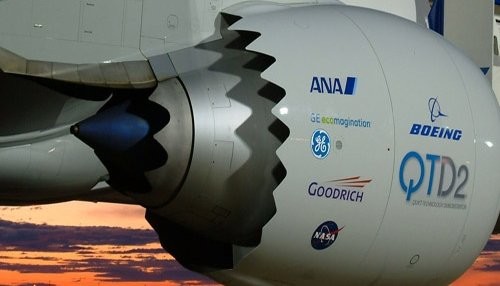
Whats the need for Chevron Nozzles on modern aviation Turbofan engines?
Let me get a little basic first. A nozzle is any hollow cylinder which is larger in circumference at the inlet side and narrower at the outlet. Hence a turbofan engine, ones used on modern airliners like the Boeing 737 and the Airbus A320 are essentially, nozzles.
A modern airliner engine is a TURBOFAN engine. This is a modified jet engine.
What is a jet engine? Simply put, suck air in through the front, compress it, put it in a combustion chamber, mix it with fuel, add a flame which leads to a HUGE controlled explosion inside the combustion chamber the pressure of which is used to drive a set of high speed turbines at the rear of the engine which shoots out a narrow stream of very fast moving air out the back of the engine, which moves the aircraft forward.
What is a TURBOFAN engine? Also known as a BYPASS engine. Very simple. All you do is add an additional FAN right at the front of the Jet Engine, ahead of the air compressor. So when you look inside the front of a Boeing 737 or 787 engine, that HUGE fan you see is the TURBOFAN. As opposed to a Jet Engine which derives ALL of its thrust from the turbine blades right at the back of the engine, a TURBOFAN engine derives 70% of its thrust from this huge fan at the front. How? The air the fan throws back is not all sent into the compressor in the center, most of it bypasses the jet engine and goes out the sides of the engine casing right to the back and gets shot out at the SAME place where your jet engine is shooting out its hot air steam.
Now here is where our problem lies which is where a Chevron Nozzle comes in handy.
The air the TURBOFAN is throwing back directly is COLD and the air coming out the jet engine turbines is very very HOT. I don't want to get too technical, at a molecular level here, for the sheer lack of expertise on my part but the mixture of this air, owing to the temperature difference is very NOISY.
A Boeing 787 is a new age aircraft suited to save fuel, be lighter, use more environment friendly materials in construction and hence uses a Chevron Nozzle to counter the problem of NOISE.
A Chevron Nozzle is a relatively new concept. The Boeing 787 engines apply this concept. It simply cuts the rear circumferential end (trailing edge) of the engine, not straight but in a repeated saw-tooth pattern.
The principle of working of the Chevron Nozzle is a little hard to explain without getting technical. Simply put, imagine the flow of COLD air from the fan being directed along the shape of the Saw Tooth pattern of the Chevron Nozzle. As opposed to a regular nozzle where the air-flow being thrown back is uniform along the entire circumference, by the very shape of the chevron nozzle, the airflow converges to the center of every saw tooth apex thereby leaving a gap between each adjacent saw-tooth. The principle states that this gap reduces turbulence between the cold and hot air mixing at the back of the engine since the hot air occupies these gaps as opposed to violent mixing. It certainly isn't the most perfect solution, but even if the mixing is made partially less turbulent, noise reduces. Also it is said that a Chevron Nozzle reduces engine performance by less than 0.25%.
Having said that, most of the world thinks its just there to make the airplane look prettier, now you know better. :) Cheers.
Self Employeed
2yInquire more about this report @ https://bit.ly/3ziOZ2H Aircraft Fuel Nozzle Market Forecast to 2028 - Covid-19 Impact and Global Analysis - by Injection Mechanism (Single Injection Point Nozzle, Multiple Injection Point Nozzle); Nozzle Type (Simplex Fuel Nozzle, Duplex Fuel Nozzle); Aircraft Type (Commercial, Military); Distribution Channel (OEM, Aftermarket) and Geography